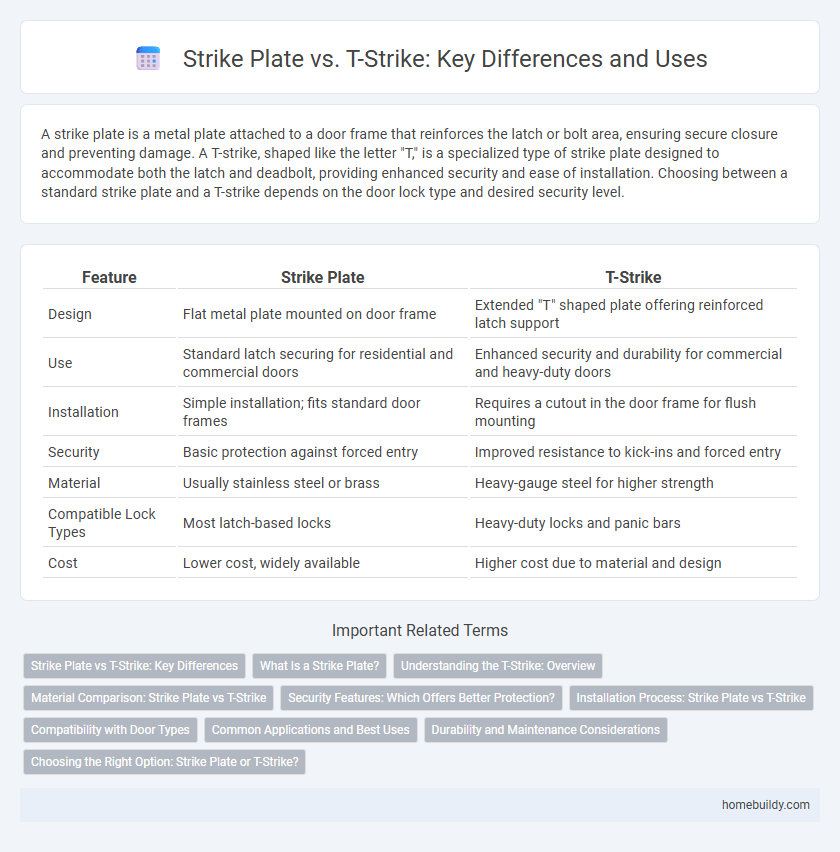A strike plate is a metal plate attached to a door frame that reinforces the latch or bolt area, ensuring secure closure and preventing damage. A T-strike, shaped like the letter "T," is a specialized type of strike plate designed to accommodate both the latch and deadbolt, providing enhanced security and ease of installation. Choosing between a standard strike plate and a T-strike depends on the door lock type and desired security level.
Table of Comparison
| Feature | Strike Plate | T-Strike |
|---|---|---|
| Design | Flat metal plate mounted on door frame | Extended "T" shaped plate offering reinforced latch support |
| Use | Standard latch securing for residential and commercial doors | Enhanced security and durability for commercial and heavy-duty doors |
| Installation | Simple installation; fits standard door frames | Requires a cutout in the door frame for flush mounting |
| Security | Basic protection against forced entry | Improved resistance to kick-ins and forced entry |
| Material | Usually stainless steel or brass | Heavy-gauge steel for higher strength |
| Compatible Lock Types | Most latch-based locks | Heavy-duty locks and panic bars |
| Cost | Lower cost, widely available | Higher cost due to material and design |
Strike Plate vs T-Strike: Key Differences
Strike plates and T-strikes serve as critical components in door security, with the strike plate typically mounted flat against the door frame to receive the latch or bolt. T-strikes, featuring a distinctive T-shaped design, extend into the frame for added reinforcement, making them ideal for high-security applications. The key differences revolve around installation, security level, and compatibility with varied door types and locking mechanisms.
What Is a Strike Plate?
A strike plate is a metal plate installed on a door frame to reinforce the latch or bolt area, ensuring secure engagement with the door lock. Unlike a T-strike, which is specifically designed to accommodate T-shaped latches often found in vertical bolt locks, a standard strike plate is typically flat and used with conventional latch mechanisms. Understanding the differences in design and application helps in selecting the proper hardware for enhanced door security and lock functionality.
Understanding the T-Strike: Overview
The T-strike is a specialized type of strike plate designed to reinforce the door frame, providing enhanced security by distributing the force of impacts over a wider area. Unlike standard strike plates, the T-strike features an extended flange that fits around the edge of the door jamb, making it ideal for doors with thick frames or for use in security doors. Its robust construction and unique shape make the T-strike a preferred choice for high-traffic or high-security applications where additional reinforcement is essential.
Material Comparison: Strike Plate vs T-Strike
Strike plates are commonly made from stainless steel or brass, offering high durability and resistance to corrosion, suitable for standard door frames. T-strikes, often constructed from thicker steel or reinforced metals, provide enhanced strength and resistance against forced entry, making them ideal for heavy-duty security applications. The material density and design of T-strikes generally result in superior impact resistance compared to traditional strike plates.
Security Features: Which Offers Better Protection?
Strike plates provide enhanced security by reinforcing the door frame with a larger metal surface that distributes impact force, reducing the risk of forced entry. T-strike plates offer improved protection on doors with narrow frames, featuring a T-shaped design that secures both the latch and deadbolt more effectively. Overall, strike plates with heavy-duty construction and longer screws typically deliver superior resistance against break-ins compared to standard T-strike models.
Installation Process: Strike Plate vs T-Strike
The installation process for a strike plate involves mortising the door frame to fit the plate flush, ensuring proper alignment with the latch bolt for secure locking. In contrast, a T-strike installs more easily by aligning over the frame surface with minimal chiseling, making it ideal for retrofitting or quick repairs. Choosing between the two depends on the door frame material and desired installation complexity, with strike plates suited for new builds and T-strikes for simpler upgrades.
Compatibility with Door Types
Strike plates typically suit standard door frames and are compatible with a wide range of interior and exterior door types, including wooden and metal doors. T-strikes are specifically designed for doors with a deeper or recessed jamb, offering enhanced compatibility with storm doors and doors requiring additional security reinforcement. Choosing between a strike plate and a T-strike depends on the door jamb depth and the door's material, ensuring proper alignment and secure locking.
Common Applications and Best Uses
Strike plates are commonly used in residential door frames for standard latch and deadbolt installation, providing reliable reinforcement and alignment. T-strikes, shaped like a "T," are preferred in commercial settings and high-traffic doors due to their enhanced strength and ability to distribute force over a larger area. Choosing between strike plates and T-strikes depends on security needs, door type, and frequency of use, with T-strikes offering superior durability for heavy-duty applications.
Durability and Maintenance Considerations
Strike plates made of heavy-duty steel offer superior durability compared to T-strikes, which are often constructed from lighter materials. The robust design of strike plates reduces wear and tear, minimizing the need for frequent maintenance or replacement. T-strikes may require more regular inspection and upkeep due to their susceptibility to bending or damage under high-impact use.
Choosing the Right Option: Strike Plate or T-Strike?
Choosing between a strike plate and a T-strike depends on the door frame type and security needs. Strike plates are standard for most residential doors, providing a flat metal surface that reinforces the latch area. T-strikes, shaped like a "T," offer enhanced reinforcement for metal frames and high-security applications, making them ideal for commercial or heavy-duty doors.
Strike plate vs T-strike Infographic

 homebuildy.com
homebuildy.com